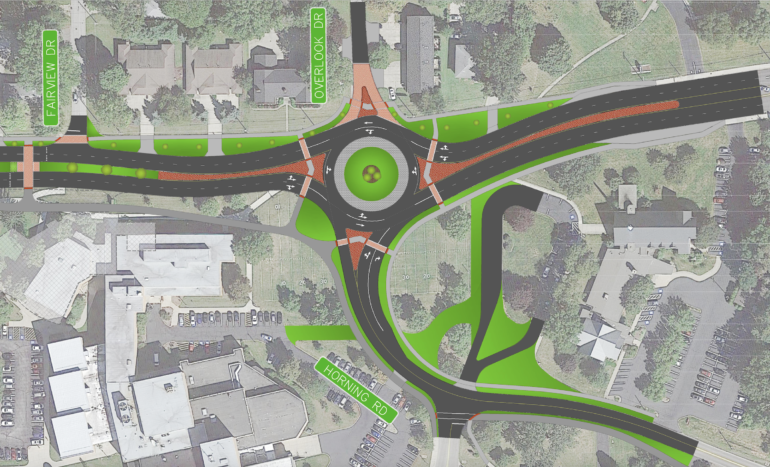In the coming years, Kent’s East Main Street will be undergoing a transformation to address the street’s high crash rate, complete with two roundabouts and crossing improvements for pedestrians.
City engineers recognized that East Main Street had a high crash history using traffic data gathered by Akron Metropolitan Area Transportation Study, which covers parts of Summit, Portage and Wayne counties.

“This section of roadway, East Main, specifically from Willow to Luther — that section was ranked number one in the city for crashes and also, [in] AMATS’ territory, was number one on their list as well,” said Jon Giaquinto, a senior engineer for the city of Kent.
Kent Council Member Heidi Shaffer Bish said the success of improvements to Summit Street contributed to the decision to further develop East Main Street.
“We improved the back of campus and access along the way: pedestrians, bicycles and also keep traffic moving along without it becoming a speedway,” Shaffer Bish said. “So we thought, well, wow, we can do the same thing for the front of campus.”
Kent State, which has been undergoing its own improvement projects through its Gateway Master Plan, worked with the city and jointly hired a consultant, Arcadis, to do design work for the project.
The budget for the overall project is $20 million, and the city has already received about $14.6 million in grants, Giaquinto said. In March, the city of Kent and Kent State signed an agreement to split the remaining local share of the project after the grants are figured in.
Some improvements, such as those to crosswalks, will be taking place this summer while some of the larger projects, like the roundabouts, won’t take place for a few years, according to Joseph Graham, interim executive director of the Office of the University Architect and university architect for Kent State.
Construction will begin around 2024 or 2025 and will take about two or three years to complete the entirety of the project, Giaquinto said.
Some improvements include:
- The creation of a tree-lined boulevard; a median with planted trees will be added between opposing lanes
- High-visibility crosswalks for pedestrians and bike crossings
- The creation of a pedestrian refuge in the center of the road to cut down on the length of crossing
- Streetlights along the length of the roadway
- Wider sidewalks on the north side of the street
- The addition of a “sidepath” — a shared path for bikes and pedestrians on the south side of the street
- The addition of two roundabouts
The city plans to add one roundabout at the intersection of East Main Street, South Willow Street and Haymaker Parkway, and one at the intersection of East Main Street and Horning Road.
The roundabout that will be located at the intersection of East Main Street and Horning Road has already stirred conversations in the university and local community. The site overlaps the location of the current Marching Golden Flashes’ practice field, and construction of the roundabout will displace the marching band’s practices, forcing them to take over the inside of the campus Ice Arena.
“[Roundabouts] serve two really important purposes,” said David Pulay, a transportation engineer for AMATS. “First of all, they keep traffic moving. It’s not like a traffic signal where traffic has to stop, and you have to wait for the light to change. So that’s huge. And they improve safety. They reduce fatal crashes by around 90% and injury crashes by around 75%. Now, you still might have some; they don’t eliminate crashes. … But they’re usually not nearly as severe.”
Kent is no stranger to roundabouts, having added three along Summit Street as a part of its Summit Street Improvement Project, which began in 2016. But Pulay said roundabouts can pose challenges for drivers unfamiliar with them — especially given that East Main Street is a four-lane road while Summit Street is a two-lane road.
“They do present some challenges until you get used to them, especially maybe drivers who aren’t familiar with them, depending on how they’re designed,” Pulay said. “I think signage is really important. It’s important to enter them in the proper lane based on where you want to exit the roundabout.”
City officials and members of the university community alike have expressed excitement about the finished product of the improvements, and Shaffer Bish said this project has been in the works for years.
“There’s so many accidents on this stretch of road that it’s now become our highest crash area in the city. I drive this way to work, and I do often see crashes,” Shaffer Bish said. “So we predict that this is going to really reduce crashes. It’s going to be kind of like a gateway to the city.”
“The university’s goal is, I can’t stress this enough, the shared collaboration with the city, that together we develop an improved travel experience for the motorists and for pedestrians that are passing through, or entering the city or entering the university,” Graham said. “So I’m really excited about it. It appears to be a transformative project for both the university and the city.”
Emma Andrus is a reporter with the Collaborative News Lab @ Kent State University, producing local news coverage in partnership with The Portager.

